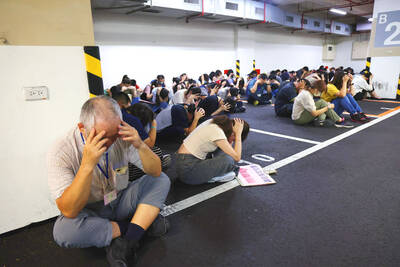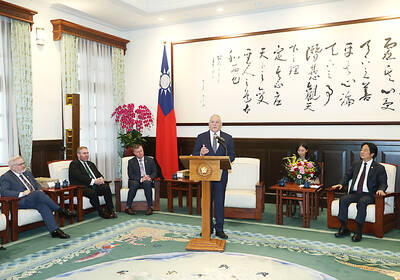National Taiwan University should respect precedent and return the bones of Bunun villagers unearthed more than four decades ago for research, the Council of Indigenous Peoples said on Monday, as Bahuan Village (馬遠) residents’ struggle to win the return of the remains draws national attention.
University researchers dug up more than 60 skeletons from the Loiq gravesite of the village in Hualien County’s Wanrong Township (萬榮) in the 1960s.
The university has said the excavation was done with the permission of village leaders after it learned that there were plans to move the burial ground, the village’s self-help association said.
The village had acted under compulsion, it said, calling for the skeletons to be returned.
“Our homes were spread out widely, so many people did not know [about the excavation] at the time,” self-help association spokesman Alang Mangloauan said, adding that university researchers had “asked” villagers for their consent through local police, who were the main representatives of the national government.
The bodies at the site had been buried between 1933 and 1955, after villagers were forced to relocate from Nantou County by the Japanese colonial government, he said.
In a statement, the council promised to negotiate with the university for the skeletons’ return and called on the university to respect its own precedents, including its return of the bones of Sediq chief Mona Rudao to Nantou County for burial in 1973.
Mona’s remains ended up as a specimen in the university’s archeology department after he was killed leading the unsuccessful 1930 Wushe Revolt, the last major Aboriginal uprising against Japanese colonial rule.
While acknowledging that it lacks legal power to compel the university to return the remains, the council called on the university to respect the spirit of the provisions of the UN Declaration on the Rights of Indigenous Peoples that grant indigenous rights over ancestral bones in government possession.
Non-partisan Solidarity Union Legislator May Chin (高金素梅), who is part Atayal, is scheduled to host talks between the Ministry of Education, National Taiwan University and village representatives later this week.
Control Yuan Vice President Sun Ta-chuan (孫大川) has applied for an investigation to be conducted.

Taipei on Thursday held urban resilience air raid drills, with residents in one of the exercises’ three “key verification zones” reporting little to no difference compared with previous years, despite government pledges of stricter enforcement. Formerly known as the Wanan exercise, the air raid drills, which concluded yesterday, are now part of the “Urban Resilience Exercise,” which also incorporates the Minan disaster prevention and rescue exercise. In Taipei, the designated key verification zones — where the government said more stringent measures would be enforced — were Songshan (松山), Zhongshan (中山) and Zhongzheng (中正) districts. Air raid sirens sounded at 1:30pm, signaling the

‘NON-RED’: Taiwan and Ireland should work together to foster a values-driven, democratic economic system, leveraging their complementary industries, Lai said President William Lai (賴清德) yesterday expressed hopes for closer ties between Taiwan and Ireland, and that both countries could collaborate to create a values-driven, democracy-centered economic system. He made the remarks while meeting with an Irish cross-party parliamentary delegation visiting Taiwan. The delegation, led by John McGuinness, deputy speaker of the Irish house of representatives, known as the Dail, includes Irish lawmakers Malcolm Byrne, Barry Ward, Ken O’Flynn and Teresa Costello. McGuinness, who chairs the Ireland-Taiwan Parliamentary Friendship Association, is a friend of Taiwan, and under his leadership, the association’s influence has grown over the past few years, Lai said. Ireland is

The number of people who reported a same-sex spouse on their income tax increased 1.5-fold from 2020 to 2023, while the overall proportion of taxpayers reporting a spouse decreased by 4.4 percent from 2014 to 2023, Ministry of Finance data showed yesterday. The number of people reporting a spouse on their income tax trended upward from 2014 to 2019, the Department of Statistics said. However, the number decreased in 2020 and 2021, likely due to a drop in marriages during the COVID-19 pandemic and the income of some households falling below the taxable threshold, it said. The number of spousal tax filings rebounded

A saleswoman, surnamed Chen (陳), earlier this month was handed an 18-month prison term for embezzling more than 2,000 pairs of shoes while working at a department store in Tainan. The Tainan District Court convicted Chen of embezzlement in a ruling on July 7, sentencing her to prison for illegally profiting NT$7.32 million (US$248,929) at the expense of her employer. Chen was also given the opportunity to reach a financial settlement, but she declined. Chen was responsible for the sales counter of Nike shoes at Tainan’s Shinkong Mitsukoshi Zhongshan branch, where she had been employed since October 2019. She had previously worked